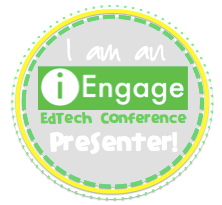Session 6: Inferring Ideas from Visual and Multimodal Texts
The session began with a discussion of the importance of students being able to infer ideas from visuals. It is crucial to teach students how to READ and APPLY visual information in a text to support their comprehension. Inferring ideas from visuals is not about kids creating videos or illustrations. It is about teaching students to USE the information viewed to help them better understand the text. Teachers must differentiate between producing and interpreting visual information for students. To do this, teachers need to broaden the definition of "text". There are 4 types of visual and multimodal texts students should become aware of when reading: photographs, picture book illustrations, info-graphics and videos.
Photographs:
What should teachers point out to or teach students? Well, it's important to teach them that a photograph is someone's perspective on an event. Get kids to question the photographer. What is the message the photographer is trying to convey? Authors are making choices and are leaving readers to infer. Here is an example using Arnold Schwarzenegger as the subject: What is the photographer trying to convey on each magazine cover?

In addition, ask students, What digital "doctoring" did they do to the photograph (if any)? For example, sometimes parts of images are turned black and white to magnify other parts of the photograph. Why highlight or shade those parts? Click HERE for the example given to attendees at the retreat of digital doctoring.

In addition, ask students, What digital "doctoring" did they do to the photograph (if any)? For example, sometimes parts of images are turned black and white to magnify other parts of the photograph. Why highlight or shade those parts? Click HERE for the example given to attendees at the retreat of digital doctoring.
Picture Book Illustrations:
Picture books typically have hand-drawn illustrations, especially in graphic novels. Sophisticated and complex illustrations or visuals are sometimes the *power* conveying meaning in the text. Asking the following questions can start great conversations in the classroom: What can be inferred on pages with no text, only pictures? How is the text integrated with the illustrations? How is the page with the pictures laid out? For example, teachers may point out how there is big text with small images, or vice versa. Fox by Margaret Wild and Waiting for Mama by Lee Tae-Jun were suggested mentor texts that provide powerful visuals.
Info-graphics:
Info-graphics:
Students need to pay attention to time lines, charts, diagrams, etc. Teach students how to READ all of the nonfiction text features a book has to offer. Students can extract pertinent information from those graphics, so make sure they know not to just read the print within paragraph format. Get students to infer ideas from the visuals. Many texts have lots of information displayed in a visual way. Sometimes info-graphics *are the text*!
As you can see with the examples above, meaning doesn't come in just paragraph format. Teachers must explain to students how information is shared with the reader within text features. This strategy isn't only for students at the secondary level. It must start at the pre-emergent levels as young as preK. Here is something to think about. Many questions on tests are taken from learning done within info-graphics, so wouldn't it be wise to teach students how to navigate those info-graphics? Here is a graphic organizer you may find useful.
As you can see with the examples above, meaning doesn't come in just paragraph format. Teachers must explain to students how information is shared with the reader within text features. This strategy isn't only for students at the secondary level. It must start at the pre-emergent levels as young as preK. Here is something to think about. Many questions on tests are taken from learning done within info-graphics, so wouldn't it be wise to teach students how to navigate those info-graphics? Here is a graphic organizer you may find useful.
Videos:
On standardized assessments, students are often shown 2-3 minute video clips and are then expected to answer questions based on those clips. Right? Well, we were told at the retreat to show students short clips often in the classroom. No, that doesn't mean watch full-length feature films, while you work on your lesson plans. It means, show students video clips that coincide with a text they are reading. There is a certain power in short clips. Teachers need to get kids articulating about what they see and hear, then put those observations into words to express the message of the video. Teach students how to evaluate and interpret the message, along with how to track and take note of important parts of videos.
I contemplated putting the following video into this post, while it sat in my drafts folder. It is quite powerful and involves a car accident, so watch at your own discretion. This video clip is certainly not something you would show little people, but it can give you a sense of how to interpret short video clips with your students. A close reading discussion guide accompanies the video, since it was given to us at the retreat.
Quite thought-provoking, right? At the retreat, attendees were asked to listen to the clip and take notes on what we hear (no visual provided). We were then asked to watch the video and take additional notes on what we see. When implementing this with your students, keep in mind discussions should apply the close reading framework, which involves 3 phases: Understand the Message, Interpret the Message and Evaluate the Message. Click the image below to download a copy for yourself.
I contemplated putting the following video into this post, while it sat in my drafts folder. It is quite powerful and involves a car accident, so watch at your own discretion. This video clip is certainly not something you would show little people, but it can give you a sense of how to interpret short video clips with your students. A close reading discussion guide accompanies the video, since it was given to us at the retreat.
It was suggested teachers bring in visuals and videos for a half dozen of the units they teach to give students ample opportunities to practice. Visuals allow students to capture the connections between the key details and can show the emphasis on key principles of a topic. Videos promote ease of recording details and allow students to capture nuances within the clips.
It certainly is advantageous, when students record observations, they are able to watch the video multiple times. It's considered *close reading* video-style. Teach students how to take dual notes on what they see and what they hear. Students may be asked to just "listen and not see" a video at first, like we were asked to do with the accident video.
The Video Notes graphic organizer can help students encompass sounds heard through music, instruments, noises, volume and silence (which can be the most powerful), along with words spoken, shouted, whispered, sung, etc. Students also embrace details in setting, characters, movements, transitions, pacing, along with printed text, scrolling, as well as overlaid and superimposed images in the background with their sense of sight.
It certainly is advantageous, when students record observations, they are able to watch the video multiple times. It's considered *close reading* video-style. Teach students how to take dual notes on what they see and what they hear. Students may be asked to just "listen and not see" a video at first, like we were asked to do with the accident video.
It's useful to have students collect and record observations on still/non-moving images before moving on to videos. Make sure students can note observations, but not make interpretations at first. Students should be able to note the details of what they see in visuals, such as facets relevant to photographs (setting, objects, people, subjects, actions) and info-graphics (source, text, visuals, organization, data, main idea). This is vital information! Take note of how the visuals are laid out in the text. Ask students, Are they in sequential, compare/contrast, or main idea/detail format?
VideoNot.es can be used with students for digital note-taking. Click HERE and HERE for more information on how it works, but in general, this site pulls up a video, allows side bar space for note-taking and can be time stamped and re-used at a later date. We were told SmarterBalance and PARCC use this type of system. Additionally, Big Picture Apples to Apples is a recommended game to get students to make and take observations about illustrations.
Last, but not least, many of us are hearing about the power of *paired texts*. Teachers need to remember that paired texts can and should include multimodal texts, not just books. For example, paired texts could be a political cartoon connected to an article, or an info-graphic that can be compared to a short story, since they focus on the same topic. Analysis is what students should be doing! Paired texts do not have to be two books. How about text sets or multimodal text sets? For example, have students compare The Giving Tree book to the 1973 movie read by Shel Silverstien and then, to the cartoon or claymation version of the book. They're all different!
Overall, try to incorporate experiences of inferring ideas from visual and multimodal texts frequently throughout the year. It's recommended students work on at least one text per week. Teachers need to look for small-dose opportunities. Have students *read* the illustrations of complex picture books and use animated movie shorts. Ending a unit with a culminating video is fabulous review for the students!
Next up in the mini-series is Revitalizing the Writing Process and Using Mentor Texts to Teach Sentence Variety, so stay tuned. :)










































Thank you for all this great information! I appreciate your suggestions on paired texts do not have to be just books. The state assessments have moved into this area for us so it is even more important that our students get all the practice that they can in this area. :) I am pinning your great ideas!
ReplyDeleteLori
Conversations in Literacy
Thank you, Lori! I agree thinking outside of the proverbial box in terms of paired texts is important and that students need tons of practice inferring from multimodal texts. I appreciate your comments and support! :) XO
DeleteI appreciate that you have shared the knowledge and experiences you enjoyed this summer. It is a wealth of information and great ideas! Thank you.
ReplyDeleteThank you for saying so, Felicia! It was great seeing you the other day at the Institute. Have a great year!! :)
Delete